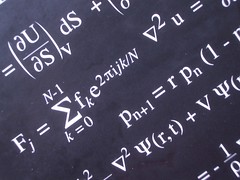 |
In a preprint Connections Adapted to Non-Negativley Graded Structures I examine the notion of connections that respect the graded structure. Such connections are akin to linear connections on vector bundles. |
Graded Bundles
Graded bundles are a particular ‘species’ of non-negatively graded the manifold that is very well behaved [1,2]. A graded bundle \(F\) is a fibre bundle for which one can assign a weight of zero to the base coordinates and a non-zero integer weight to the fibre coordinates. Admissible changes of local coordinates respect this assignment of weight. The resulting structure is a polynomial bundle with the typical fibres being \(\mathbb{R}^n\) (for some n). Note that the changes of coordinates for the fibre coordinates are not linear, but rather polynomial. We, in fact, have a series of affine fribrations
\(F := F_k \longrightarrow F_{k-1} \longrightarrow \cdots \longrightarrow F_1 \longrightarrow F_0 =: M \,,\)
where we have indicated the highest weight/degree of the coordinates. Note that the arrow on the far right is a vector bundle. Examples of graded bundles include higher order tangent bundles and vector bundles. The ethos one can take is that graded bundles are ‘non-linear’ vector bundles, and so the question of connections that in some sense respect the graded structure is a natural one.
Connections
The notion of a connection in many different guises, such as a covariant derivative or a horizontal distribution, can be found throughout differential geometry. In physics, connections are central to the notion of gauge fields such as the electromagnetic field. Connections also play a role in geometric approaches to relativistic mechanics, Fedosov’s approach to deformation quantisation, adiabatic evolution via the Berry phase, and so on.
The initial approach that I take in the preprint is to generalise the notion of a Koszul connection. I phrase this in terms of odd vector fields on a particular supermanifold build from the graded bundle and a Lie algebroid (it is, up to a shift in parity, the fibre product of the Lie algebroid and the graded bundle).
Lie Algebroids
Loosely, a Lie algebroid can be viewed as a mixture of tangent bundles and Lie algebras [3]. A little more carefully, a Lie algebroid is a vector bundle
\(\pi : A \longrightarrow M\)
that comes equipped with a Lie bracket on the space of sections, together with an anchor map
\(\rho : Sec(A) \longrightarrow Vect(M) \)
that satisfy some natural compatibility conditions. In particular, the anchor map is a Lie algebra homomorphism.
Lie algebroids also have a very economical description in terms of Q-manifolds, i.e., supermanifolds equipped with an odd vector field that squares to zero [4]. The example to keep in mind here is the tangent bundle, which is canonically a Lie algebroid: the bracket is the standard Lie bracket between vector fields and the anchor is just the identity. Dual to this picture is the de Rham complex. We can understand differential forms as functions on the shifted or anti- tangent bundle, which is a supermanifold. The homological vector field we recognise as the de Rham differential. Lie algebroids can be defined via their analogue of the de Rham complex. For the case of a Lie algebra (a Lie algebroid over a point) we have the Chevalley–Eilenberg complex. The general case is kind of a mix of these two extremes.
With this in mind, there is a general mantra: whatever you can do with tangent bundles you can do with Lie algebroids. This includes the construction of connections.
Adapted Connections
In the preprint, I define and study connections that take their values in Lie algebroids over the manifold \(M\). I define the notion of a connection that respects the structure of a graded bundle (think linear connections and vector bundles) and show that the set of such objects for any graded bundle and Lie algebroid is non-empty. I refer to these as weighted A-connections. I show how one can construct a quai-action of a Lie algebroid on a graded bundle and that this action respects the graded structure.
The notions also generalise directly to multi-graded bundles, such as double vector bundles. As far as I know, the notion of a connection adapted to a double vector bundle is completely new.
Potential Applications
Given that graded bundles, Lie algebroids and connections play important roles in geometric mechanics, as do double vector bundles, it is possible that weighted A-connections could find applications here. In particular, there could be some scope here in control theory and the reduction of higher derivative systems by symmetries. All this remains to be explored.
References
[1] J. Grabowski & M. Rotkiewicz, Graded bundles and homogeneity structures, J. Geom. Phys. 62 (2012), no. 1, 21–36.
[2] Th.Th. Voronov, Graded manifolds and Drinfeld doubles for Lie bialgebroids, in: Quantization, Poisson Brackets and Beyond, volume 315 of Contemp. Math., pages 131–168. Amer. Math. Soc., Providence, RI, 2002.
[3] J. Pradines, Representation des jets non holonomes par des morphismes vectoriels doubles soudes, C. R. Acad. Sci. Paris Ser. A 278 (1974) 152—1526.
[4] A.Yu. Vaıntrob, Lie algebroids and homological vector fields, Uspekhi Matem. Nauk. 52 (2) (1997) 428–429